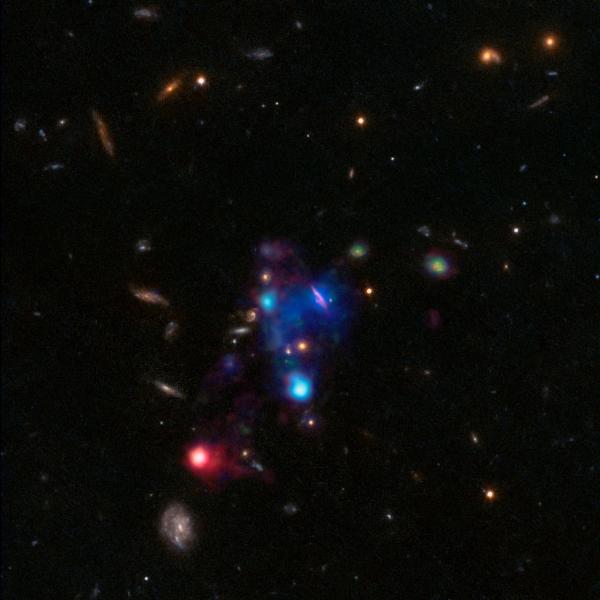A giant gas cloud enclosing a dozen galaxies…
A team of astrophysicists from the Institut de Recherche en Astrophysique et Planétologie of Toulouse, the Laboratoire d’Astrophysique of Marseille and the Centre de Recherche Astrophysique of Lyon, have just discovered a giant cloud of ionized gas. This discovery was part of a research program conducted with the VLT’s MUSE Instrument in order to study the impact of the environment on the galaxy evolutionary mechanisms. This cloud of gas measures more than 300,000 light years, i.e. three times the diameter of the Milky Way, and envelops ten galaxies. It’s the largest structure of this kind known to date. It is located within a particularly dense region of a group of galaxies called COSMOS-Gr30, located 6.5 billion light years from Earth. Intrigued, this team sought to understand the origin of this gas and the sources responsible for its ionization.

Large gas clouds have already been observed in the past. But they were generally smaller, fainter, and often associated with very massive galaxies hosting a giant black hole whose intense radiation could explain their heating. This discovery highlights all new processes, certainly linked to the very dense environment in which this structure is located. Indeed, this cloud of gas could be a testimony to the violent processes usually invoked to explain the sudden end of star formation within galaxies populating the most dense structures of the Universe.
This extraordinary cloud was discovered and studied in detail thanks to the incredible sensitivity of the MUSE instrument, developed for the ESO’s Very Large Telescope (VLT) in Chile. Covering the visible wavelengths, MUSE combines both the possibilities of an imaging instrument and the ability of a spectrograph, making it a powerful and unique tool for enlighting celestial objects that were previously in the shadows.
The power of MUSE has allowed astrophysicists to understand that this large amount of gas is not primordial. It has probably been extirpated from galaxies, either during violent interactions that can even lead to the fusion of galaxies, or by superwinds resulting from the activity of giant black holes or from the cumulative effect of supernovae. They also studied how this cloud could be heated so far away from the galaxies. They concluded that this gas structure is ionized by various processes: most of it seems to be heated by the intense radiation emitted by newly formed stars in galaxies, and by the shocks between the gas clouds ejected from these galaxies. In a more localized region of this cloud, a giant black hole in the active phase would be responsible for the heating of the gas.
This discovery shows that the encounter of several galaxies at the intersection of the filaments of the cosmic web can generate a series of processes that eject an enormous amount of gas outside the galaxies and that there are mechanisms capable of ionizing this gas at a very large distance from the galaxies. This phenomenon may be a prelude to the formation of very massive galaxies, without gas or star formation, at the centre of large structures such as galaxy clusters, and this kind of phenomenon may be partly responsible for stopping the formation of stars in these structures. It is also possible that the gas may reform a disk, which could explain the existence of passive galaxies with a thick disk of rather old stars and a younger disk, as observed in the Milky Way.
In order to improve the understanding of this structure, this team wants to begin new observations in other wavelength ranges, especially with the ALMA and NOEMA interferometers.
Case to follow…
Further resources:
- Article : Epinat, Contini, Finley, et al., Ionised gas structure of 100 kpc in an over-dense region of the galaxy group COSMOS-Gr30 at z ~ 0.7, 2017, Astronomy & Astrophysics, in press, ArXiv e-prints [arXiv:1710.11225]
- ESO Publication : A gigantic cosmic bubble
IRAP Contact :
- Thierry Contini, IRAP – (OMP, CNRS/Université Paul Sabatier), thierry.contini@irap.omp.eu – 06 62 64 12 68






